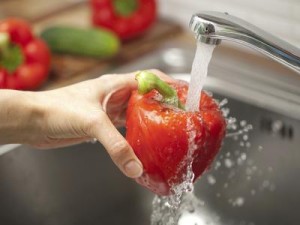A couple of weeks ago my friend Matt Shipman, who runs The Abstract, asked me to answer a question about the best way to wash produce in the home.
I’ve received different iterations of this question up from extension agents, media and at Food Safety Talk with Don Schaffner. I’ve sort of settled on this: use water, vigorously running out of the tap, but don’t expect washing to make your produce risk-free. 
I used to say that washing in the home did nothing for food safety but Don, the smart math dude I hangout with electronically, reminded me that saying it does nothing is incorrect – it does something.
Just not as much as folks may expect.
Matt captured the discussion for a blog post, below.
Here’s the question we got: “What is the most effective means of cleaning fresh produce at home to remove micro-organisms that could make you sick?”
“Vigorously rinsing the produce under running water is the most effective way of removing the microbes that cause foodborne illnesses – you don’t need soap or any special cleaning products,” says Ben Chapman, a food safety researcher at NC State. “But while washing your produce may remove some pathogens, it doesn’t eliminate risk altogether.”
“At best you get a two log reduction – that’s a 99 percent reduction in microbes,” Chapman says. “That seems good, but it’s not great. While washing can help reduce pathogen contamination, it shouldn’t be relied on as the only control measure.”
By comparison, cooking food results in a six log reduction in viable microbes. That means the population of viable microbes gets cut by 99.9999 percent(!).
The difference between 99 percent and 99.9999 percent is important because some fruits and vegetables can be contaminated with thousands of microbes. And we know that, on average, most microbial food-borne illnesses are caused by foods that are contaminated by only 20-30 organisms (the mean infectious dose for some of the pathogens of concern -ben).
So washing off 99 percent of the microbes doesn’t help much if a food was carrying thousands of microbes to start with.
Buy from producers who know what the risks are and are employing strategies to reduce them. Ask lots of questions.
Some good references on how I’ve arrived at my answer are here: Bassett and McClure 2008; Parish et al., 2003; Parnell et al., 2005; Verrill et al., 2012. There are other good ones out there too including this fact sheet from Christine Bruhn and others.
